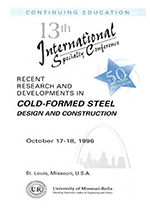Session Dates
17 Oct 1996
Abstract
Geometric imperfections and residual stresses influence the behavior and ultimate strength of cold-formed steel members. Advanced analytical models (i.e. nonlinear finite element models) must reflect this by including appropriate geometric imperfections and residual stresses. To date, little has been done to summarize the existing literature on these topics. As a result, no consensus exists for what magnitudes or distributions should be used when including geometric imperfections and residual stresses in the analysis, In this paper existing literature is reviewed and a new series of measurements carried out with the goal of providing basic guidelines for the use of geometric imperfections and residual stresses in analytical models. The study results in promising methods for the measurement of imperfections, and shows that the existing literature can be used to at least partially realize the goal of using "practical inputs" in advanced analytical models.
Department(s)
Civil, Architectural and Environmental Engineering
Research Center/Lab(s)
Wei-Wen Yu Center for Cold-Formed Steel Structures
Meeting Name
13th International Specialty Conference on Cold-Formed Steel Structures
Publisher
University of Missouri--Rolla
Document Version
Final Version
Rights
© 1996 University of Missouri--Rolla, All rights reserved.
Document Type
Article - Conference proceedings
File Type
text
Language
English
Recommended Citation
Schafer, Benjamin W. and Pekoz, Teoman, "Geometric Imperfections and Residual Stresses for Use in the Analytical Modeling of Cold-formed Steel Members" (1996). CCFSS Proceedings of International Specialty Conference on Cold-Formed Steel Structures (1971 - 2018). 4.
https://scholarsmine.mst.edu/isccss/13iccfss/13iccfss-session11/4
Geometric Imperfections and Residual Stresses for Use in the Analytical Modeling of Cold-formed Steel Members
Geometric imperfections and residual stresses influence the behavior and ultimate strength of cold-formed steel members. Advanced analytical models (i.e. nonlinear finite element models) must reflect this by including appropriate geometric imperfections and residual stresses. To date, little has been done to summarize the existing literature on these topics. As a result, no consensus exists for what magnitudes or distributions should be used when including geometric imperfections and residual stresses in the analysis, In this paper existing literature is reviewed and a new series of measurements carried out with the goal of providing basic guidelines for the use of geometric imperfections and residual stresses in analytical models. The study results in promising methods for the measurement of imperfections, and shows that the existing literature can be used to at least partially realize the goal of using "practical inputs" in advanced analytical models.



